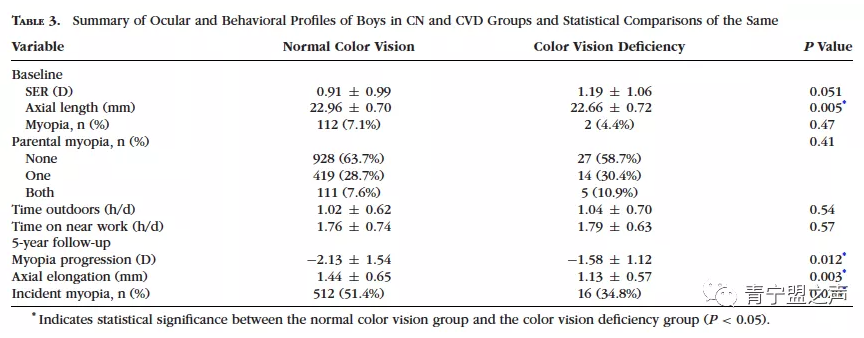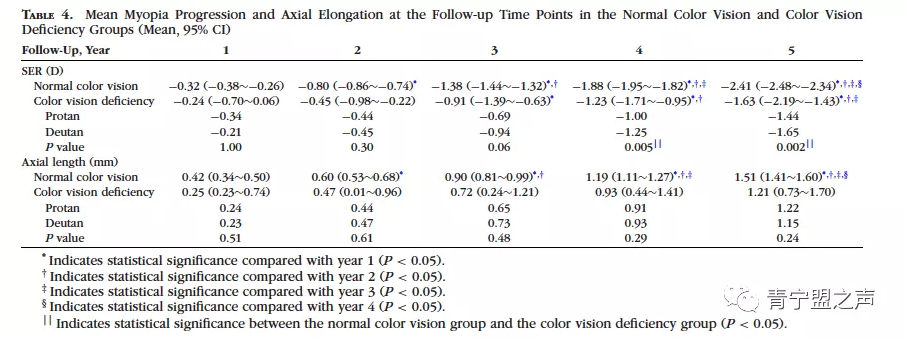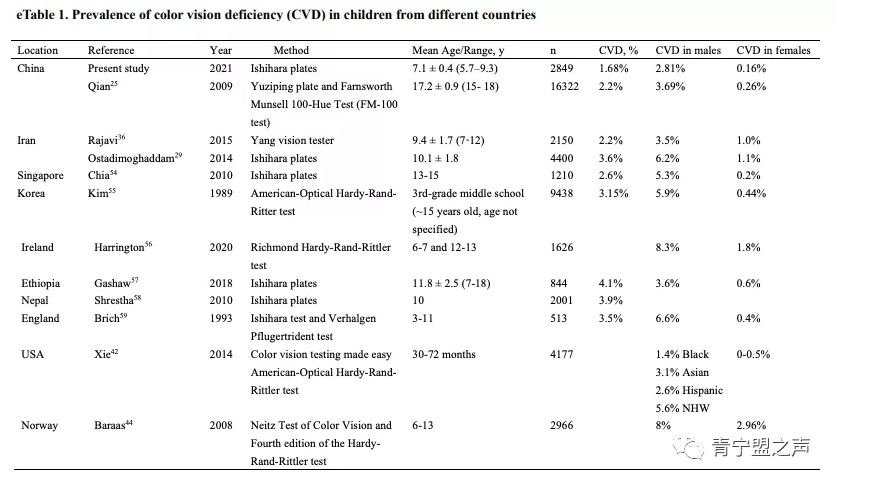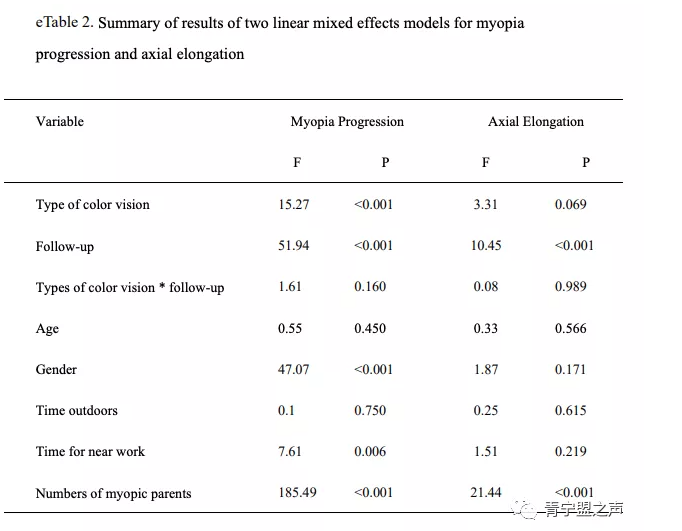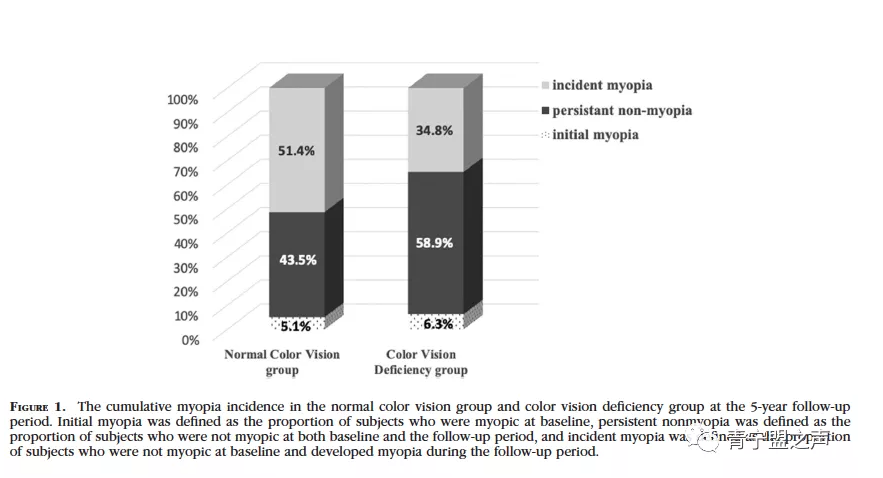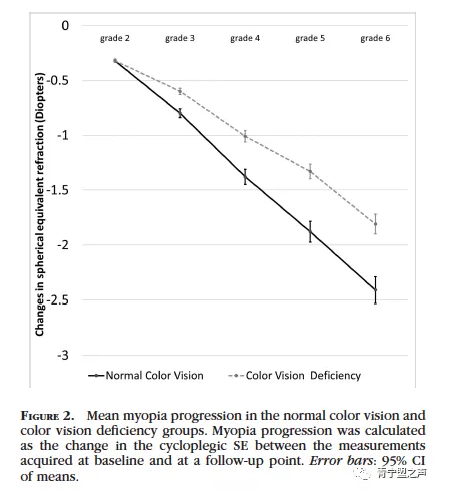Association Between Color Vision Deficiency and Myopia in Chinese Children Over a Five-Year Period
Investigative Ophthalmology &Visual Science IF=4.79 Jiahe Gan, Shi-Ming Li, David A. Atchison, Meng-Tian Kang, Shifei Wei, Xi He,Weiling Bai, He Li, Yuting Kang, Zhining Cai, Lei Li, Zi-Bing Jin, and Ningli Wang PURPOSE. To explore the relationship of color vision deficiency with myopia progression and axial elongation in Chinese primary school children during a five-year cohort study. METHODS. A total of 2849 grade 1 students (aged 7.1 years) from 11 primary schools were enrolled and followed up for five years. Cycloplegic autorefraction and axial length were measured annually. Color vision testing was performed using Ishihara’s test and the City University color vision test. RESULTS. The prevalence of color vision deficiency was 1.68%, with 2.81% in boys and 0.16% in girls. Color-deficient cases consisted of 91.6% deutan and 8.3% protan. Over the five years, the cumulative incidence of myopia was 35.4% (17/48) in the color-vision deficiency group, which was lower than the 56.7% (1017/1794) in the color normal group (P = 0.004). Over the five-year study period, the change in spherical equivalent refraction in the color vision–deficiency group (−1.81 D) was also significantly lower than that in the color normal group (−2.41 D) (P = 0.002). CONCLUSIONS. The lower incidence and slower progression of myopia in children with color-vision deficiency over the five-year follow-up period suggest that color-deficient individuals are less susceptible to myopia onset and development. Keywords: color vision, myopia, color vision deficiency, children Table 1: demographic and ocular biological parameters of children with normal and abnormal color vision in Grade 1 of primary school at baseline. Compared with children with normal color vision, the proportion of boys in children with abnormal color vision is higher. There is no difference in diopter, ocular axis, number of parents' myopia, outdoor activity time and close working time between the two groups. Table 2: at the end of the 5-year follow-up, compared with the abnormal color vision group, the diopter of the normal color vision group shifted more towards myopia, the ocular axis was longer, and the prevalence of new myopia was higher. Table 3: ocular biological parameters of boys in normal color vision group and abnormal color vision group at baseline and at the end of 5-year follow-up. At baseline, the ocular axis of boys with abnormal color vision was shorter than that of boys with normal color vision; At the end of the 5-year follow-up, the refractive progression and axial growth of boys in the color vision abnormal group were lower than those in the color vision normal group, and the prevalence of new myopia was lower than that in the color vision normal group. Table 4: diopter progress of normal color vision group and abnormal color vision group in primary school during the first to fifth follow-up. At the fourth and fifth follow-up, diopter progress of normal color vision group was significantly higher than that of abnormal color vision group. Prevalence of color vision abnormalities in children in China and around the world 1 Supplementary Table 2: linear mixed model of diopter progression and axial growth Fig. 1: incidence rate of 5 years of new myopia and primary myopia rate in normal color vision group and abnormal color vision group. At baseline, there was no difference in the original myopia rate between the two groups. But at the end of 5 years of follow-up, the incidence rate of myopia in the normal color group was 5 higher than that in the color vision group (51.4% vs. 34.8%). Figure 2: diopter progress in normal color vision group and abnormal color vision group. At the 4th and 5th follow-up, the diopter progress in normal color vision group was significantly higher than that in abnormal color vision group. In summary, this prospective cohort study found that children with color vision deficiencies had a lower incidence of myopia, slower myopic progression, and less axial elongation than children with normal color vision. These findings suggest that individuals with CVD are less susceptible to myopia onset and progression, and this may be related to altered cone ratios or cone contrast. More studies should be conducted to further investigate the relationship of color vision status with myopia progression and axial elongation in different racial populations. This prospective cohort study found that the incidence rate of myopia in children with color vision was lower (35.4% vs. 56.7%) and myopia progression was slower than that in normal children (-1.81 D vs. -2.41 D). These findings suggest that children with abnormal color vision are relatively less susceptible to myopia, which may be related to the imbalance of the relative proportion of cone cells or the difference of relative sensitivity. Original link:https://doi.org/10.1167/iovs.63.2.2

